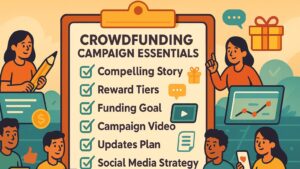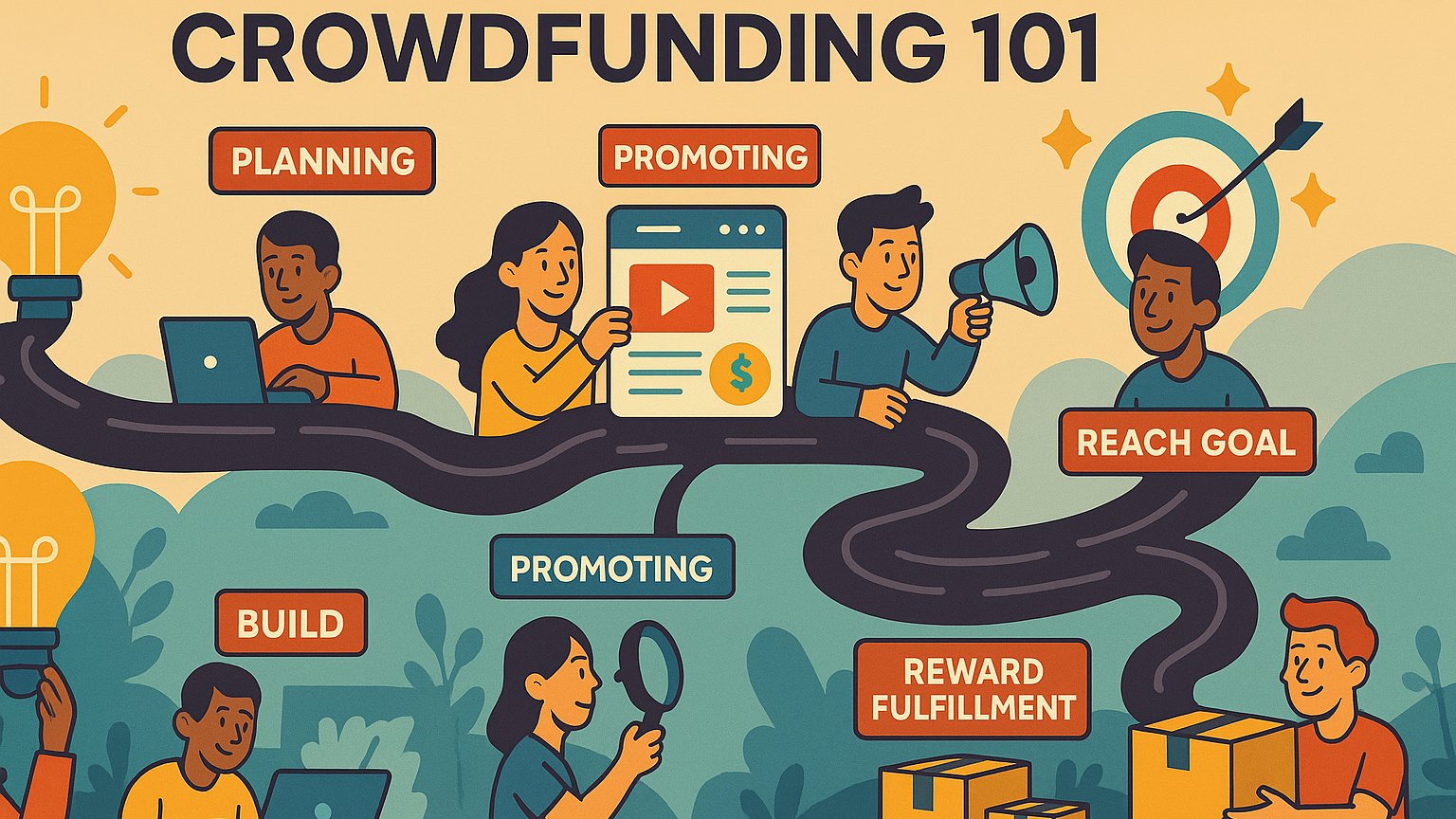Crowdfunding 101: Everything You Need to Launch with Confidence
Imagine launching your dream project with the support of hundreds—or even thousands—of passionate backers from around the world. That’s the promise of crowdfunding, a powerful fusion of storytelling, technology, and grassroots enthusiasm that’s completely transformed how creators, entrepreneurs, and changemakers bring their visions to life. Whether you’re an artist looking to release your next album, a startup developing a revolutionary gadget, or a nonprofit championing a global cause, crowdfunding gives you a direct line to the people who care about what you’re building.
In this pillar guide, you’ll discover the full landscape of crowdfunding—from how it works and what models to consider, to essential legal knowledge and myth-busting truths. Think of this as your launchpad for not just running a campaign, but running a campaign that stands out, connects, and succeeds.

Crowdfunding Basics
Welcome to the ultimate hub for Crowdfunding Basics — your gateway to understanding one of the most powerful funding movements of our time! Whether you’re curious about how crowdfunding works, the psychology behind why people give, or the secrets to a campaign’s viral success, you’ll find it all here. We’ve packed this page with everything from beginner-friendly explainers and industry history to success strategies, legal essentials, and the future of

Crowdfunding Campaign Essentials
Welcome to the action center of Campaign Essentials — the master key to unlocking a successful crowdfunding launch! Whether you’re mapping out your first campaign or fine-tuning your next big project, this is where great ideas become unstoppable realities. Inside, you’ll find a treasure trove of expert strategies, planning templates, launch blueprints, daily action plans, and time-tested secrets to guide you every step of the way. From setting the perfect

Crowdfunding Models Explained
Welcome to Funding Models Explained — your deep dive into the fascinating world of how crowdfunding truly works! Whether you’re launching your first campaign, investing in the next big startup, or just exploring your options, understanding the right funding model is the game-changer you can’t afford to miss. Here, we break down every major crowdfunding type — from reward-based to equity, from donation to debt, and even royalty and hybrid

Crowdfunding Key Terminology
Welcome to Key Terminology — your backstage pass to speaking the language of crowdfunding like a pro! Whether you’re launching your first campaign, backing an exciting project, or diving into the world of equity, rewards, or donations, mastering the right terms can transform confusion into confidence. Think of this as your ultimate crowdfunding dictionary — packed with simple explanations, real-world examples, and the must-know definitions that will set you apart.

Crowdfunding Regulations & Legal 101
Welcome to Regulations & Legal 101 — your essential guide to navigating the legal side of crowdfunding like a seasoned pro! Crowdfunding opens doors to incredible opportunities, but every great campaign also needs a strong foundation of compliance, transparency, and smart legal moves. That’s where this page comes in. Whether you’re launching a reward-based project, an equity offering, a donation drive, or even real estate crowdfunding, we’ll help you stay

Crowdfunding Success and Failure Analysis
Welcome to Success & Failure Analysis — the ultimate behind-the-scenes look at what makes crowdfunding campaigns soar… or stumble. Here, we break down real case studies, viral successes, unexpected failures, dramatic comebacks, and the hidden lessons that most creators never see. From million-dollar board games to overhyped gadgets that flopped, you’ll get the full story — the wins, the losses, and everything in between. Explore how timing, communication, reward strategy,

Crowdfunding vs Traditional Funding
Welcome to Crowdfunding vs Traditional Funding — where we put crowdfunding under the spotlight and show you exactly how it stacks up against every other funding path out there! Whether you’re deciding between crowdfunding and venture capital, weighing a grant application, or debating whether to bootstrap your dream, this is your ultimate guide to making the smartest move. Dive into detailed comparisons between crowdfunding and loans, accelerators, seed rounds, angel

Crowdfunding Myths and Facts
Welcome to Crowdfunding Myths & Facts — your ultimate guide to separating truth from fiction in the world of crowdfunding! If you’ve ever heard that crowdfunding is “easy money,” “only for startups,” or that “backers will magically find you,” it’s time for a reality check. Crowdfunding has launched billion-dollar brands and life-changing ideas — but it’s also surrounded by myths that trip up even the smartest creators. Here, we bust
Crowdfunding Basics: What It Is and Why It Matters
Crowdfunding is the act of raising money from a large number of individuals, typically via online platforms, to fund a project, product, cause, or venture. Rather than relying on one big investor, crowdfunding taps into a crowd of small supporters, each contributing a manageable amount in exchange for rewards, equity, or simply the joy of helping something meaningful take shape.
This method has democratized funding across industries. It’s no longer just about who you know—it’s about how well you tell your story and rally a community. From filmmakers to tech inventors to eco-conscious startups, crowdfunding has sparked an age of creative empowerment and entrepreneurial independence.
Platforms like Kickstarter, Indiegogo, GoFundMe, and SeedInvest have made it easy to set up campaigns, share them with the world, and collect funds in real time. The rise of social media has only amplified crowdfunding’s impact, letting campaigns go viral overnight.
Campaign Essentials: Crafting the Ultimate Crowdfunding Launch
Running a successful campaign isn’t just about having a good idea—it’s about strategy, clarity, and emotional resonance. A compelling crowdfunding campaign has several moving parts working in harmony.
Your story is your lifeline. You need a powerful narrative that explains who you are, what you’re doing, and why it matters. Backers want to connect with your mission on a personal level. Don’t just explain what your product does—show how it solves a problem or changes lives.
Visuals seal the deal. High-quality photos, graphics, and especially video are essential. A short video pitch that conveys excitement, trust, and authenticity can make the difference between a curious visitor and a committed backer.
Rewards are your campaign’s currency. Offering creative, tiered perks that align with your campaign’s theme and value proposition gives supporters a reason to contribute more. Whether it’s an early-bird product, exclusive merch, or a personal thank-you, every reward should feel like a badge of honor.
Timing is everything. Plan a campaign window that creates urgency without rushing. Most successful campaigns last between 30 to 45 days. During this time, you need a calendar of updates, social posts, emails, and outreach efforts to keep the energy high and the backers engaged.
Funding Models Explained: Choose Your Own Adventure
Not all crowdfunding is created equal. Different funding models cater to different needs and expectations. Understanding the distinctions is key to picking the right approach.
Reward-based crowdfunding is the most popular model, used on platforms like Kickstarter and Indiegogo. Here, backers pledge money in exchange for rewards—often the final product or exclusive extras. It’s ideal for creators and startups launching tangible goods.
Equity crowdfunding lets backers invest in a company in exchange for shares. It’s regulated by the SEC and platforms like StartEngine, SeedInvest, and Republic specialize in it. This model is great for startups looking to scale and invite the public to become stakeholders.
Donation-based crowdfunding is driven by goodwill. Used by nonprofits, individuals, and causes, this model doesn’t offer rewards or equity—just the satisfaction of helping. GoFundMe is the leading platform here.
Debt-based crowdfunding, also known as peer-to-peer lending, allows people to lend money to individuals or businesses, expecting repayment with interest. Platforms like LendingClub and Funding Circle offer this model, which is ideal for those who need capital but prefer to avoid traditional bank loans.
Hybrid models are also emerging, offering combinations like rewards plus equity or donations with stretch goals.
Key Terminology: The Language of Crowdfunding
Before you dive in, it helps to speak the language of crowdfunding. These terms will come up frequently throughout your journey:
- Campaign: The project you create on a crowdfunding platform, including its pitch, goals, rewards, and updates.
- Backer: Someone who contributes money to your campaign.
- Goal: The target funding amount you aim to raise.
- Stretch Goal: An additional goal set after the original is surpassed, often unlocking bonus rewards or features.
- Pledge: The amount a backer commits to your campaign.
- Funding Threshold: The minimum amount you must raise to receive the money. Some platforms are “all or nothing”—you must hit the goal to collect funds.
- Perk or Reward: The item or experience backers receive in exchange for their pledge.
- Pre-launch Page: A teaser page that collects emails and builds anticipation before the campaign officially begins.
- Updates: Regular messages posted to your campaign page to keep backers informed and excited.
- Fulfillment: The process of delivering rewards to your backers after the campaign ends.
Regulations and Legal 101: Staying Safe, Smart, and Compliant
Crowdfunding isn’t a legal free-for-all. Especially in equity and debt crowdfunding, there are regulations in place to protect both creators and backers. Knowing the basics keeps you in the clear.
In the United States, the Securities and Exchange Commission (SEC) governs equity crowdfunding. Companies must comply with Regulation Crowdfunding (Reg CF), which includes financial disclosures, investment caps, and platform oversight. You’ll often need to file Form C and share financials based on your funding target.
For reward and donation campaigns, the legal concerns are less intensive, but still important. Your campaign should deliver what it promises. Misleading or fraudulent campaigns can result in refunds, bans from platforms, and even lawsuits.
Sales tax, income tax, and international shipping laws also come into play—especially if you’re offering physical goods as rewards. Consult an accountant or legal advisor if your campaign has complex logistics or global reach.
Protect your intellectual property. While crowdfunding exposes your ideas to the world, that visibility can attract copycats. Consider provisional patents, trademarks, or NDAs before you launch if your idea is especially unique.
Success and Failure Analysis: What Really Makes a Campaign Win
Every viral crowdfunding success story has lessons behind it—and so does every campaign that falls short. Understanding both ends of the spectrum is the key to stacking the odds in your favor.
Successful campaigns almost always follow a pattern: strong pre-launch buzz, an emotionally compelling video, well-thought-out rewards, and constant engagement. They also set realistic funding goals, understand their backer demographics, and work relentlessly on marketing.
Pebble’s smartwatch campaign, for example, raised millions by addressing a tech need, showing a working prototype, and providing crystal-clear rewards. Exploding Kittens used humor, community, and clever branding to turn a card game into a multi-million-dollar hit.
On the flip side, failed campaigns often share common pitfalls: vague descriptions, low-quality visuals, unrealistic goals, lack of marketing, or poor communication during and after the campaign. One of the most overlooked reasons for failure is launching before building an audience. Crowdfunding is not a magic faucet—it’s a megaphone, and your message needs a crowd to reach.
Crowdfunding vs Traditional Funding: Which Path Is Best?
Crowdfunding vs Traditional Funding isn’t just a choice between money sources—it’s a shift in how ideas come to life. Crowdfunding reflects the rise of the creator economy, decentralized finance, and community-driven innovation. It’s where independent musicians, bold inventors, passionate activists, and first-time founders can bypass traditional gatekeepers like banks and venture capitalists.
Today, artists launch albums without record labels. Scientists crowdfund vital climate research. Small businesses rally communities to rebuild after disasters. Crowdfunding empowers everyday visionaries to fund dreams on their own terms, showing that the future of finance is powered by people, not institutions.
Even more, the social proof of a successful campaign unlocks new opportunities. Campaigns that gain momentum often attract media coverage, retail partnerships, and future investment. Crowdfunding isn’t just a way to get funded—it’s a launchpad for building a brand, validating a vision, and accelerating into bigger markets.
In the battle of crowdfunding vs traditional funding, the real winner is the creator who dares to take control.
Crowdfunding Myths: What People Get Wrong (and What You Should Know)
Despite its popularity, crowdfunding is surrounded by persistent myths. These misconceptions can derail your expectations or decisions if you’re not careful.
One common myth is that a great idea will automatically attract money. In reality, preparation and promotion are far more critical than the idea alone. Your outreach, timing, and campaign design matter more than you’d think.
Another myth is that crowdfunding is free money. While you don’t have to repay rewards or donations, you do have obligations—both financial and reputational. You’ll need to deliver rewards, communicate transparently, and manage taxes and fulfillment costs. Nothing is truly “free” in crowdfunding.
Some believe you need a massive following to be successful. While having an audience helps, even unknown creators have succeeded by building community before launch and leveraging smart PR, partnerships, and email marketing.
There’s also a fear that your idea will be stolen if you post it online. While this risk exists, visibility often outweighs the downside—especially if your execution, branding, and timeline are sharp. Plus, there are protective legal steps you can take beforehand.
Finally, many think crowdfunding is only for quirky gadgets or creative art projects. In truth, it spans healthcare, real estate, education, biotech, and everything in between. If it solves a real problem or sparks real interest, there’s a place for it.
Your Journey Starts Here: Turning Dreamers Into Doers
Crowdfunding is not a gamble—it’s a craft. It’s the art of combining purpose, audience insight, and passion into a campaign that moves people to act. With the right preparation, mindset, and strategy, you can turn a fleeting idea into a funded reality.
This is your time to bring something new into the world. Whether you’re aiming to prototype a groundbreaking invention, make a difference in your community, or explore an idea that no one’s dared try before, crowdfunding is your runway.
Study the models, speak the language, honor the legalities, and learn from those who came before you. The journey isn’t always easy, but it’s incredibly rewarding—and you’ll never walk alone. Behind every great campaign is a crowd waiting to believe.

